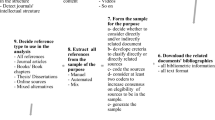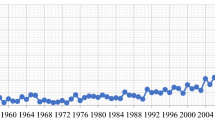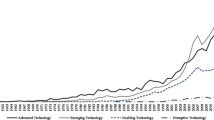Abstract
This study proposes an approach for visualizing a knowledge structure, the proposed approach creates a three-dimensional “Research focused parallelship network”, a “Keyword Co-occurrence Network”, and a two-dimensional knowledge map to facilitate visualization of the knowledge structure created by journal papers from different perspectives. The networks and knowledge maps can be depicted differently by choosing different information as the network actor, e.g. author, institute or country keyword, to reflect knowledge structures in micro-, meso-, and macro-levels, respectively. Technology Foresight is selected as an example to illustrate the method proposed in this study. A total of 556 author keywords contained in 181 Technology Foresight related papers have been analyzed. European countries, China, India and Brazil are located at the core of Technology Foresight research. Quantitative ways of mapping journal papers are investigated in this study to unveil emerging elements as well as to demonstrate dynamics and visualization of knowledge. The quantitative method provided in this paper shows a possible way of visualizing and evaluating knowledge structure; thus a computerized calculation is possible for potential quantitative applications, e.g. R&D resource allocation, research performance evaluation, science map, etc.



Similar content being viewed by others
References
Alsan, A., & Oner, M. A. (2003). An integrated view of foresight: Integrated foresight management model. Foresight, 5, 33–45.
Amsteus, M. (2008). Managerial foresight: Concept and measurement. Foresight, 10, 53–66.
Baldwin, C., Hughes, J., Hope, T., Jacoby, R., & Ziebland, S. (2003). Ethics and dementia: Mapping the literature by bibliometric analysis. International Journal of Geriatric Psychiatry, 18, 41–54.
Bhattacharya, S., & Basu, P. K. (1998). Mapping a research area at the micro level using co-word analysis. Scientometrics, 43, 359–372.
Brass, D. J., & Burkhardt, M. E. (1992). Centrality and power in organizations. Networks and Organizations: Structure, Form and Action, 191, 215.
Callon, M., Courtial, J. P., & Laville, F. (1991). Co-word analysis as a tool for describing the network of interactions between basic and technological research: The case of polymer chemistry. Scientometrics, 22, 155–205.
Cambrosio, A., Limoges, C., Courtial, J. P., & Laville, F. (1993). Historical scientometrics? Mapping over 70 years of biological safety research with coword analysis. Scientometrics, 27, 119–143.
Chiu, W. T., & Ho, Y. S. (2007). Bibliometric analysis of tsunami research. Scientometrics, 73, 3–17.
Chiu, W. T., Huang, J. S., & Ho, Y. S. (2004). Bibliometric analysis of severe acute respiratory syndrome-related research in the beginning stage. Scientometrics, 61, 69–77.
Clarke, A., Gatineau, M., Thorogood, M., & Wyn-Roberts, N. (2007). Health promotion research literature in Europe 1995–2005. The European Journal of Public Health, 17, 24–28.
Coulter, N., Monarch, I., & Konda, S. (1998). Software engineering as seen through its research literature: A study in co-word analysis. Journal of the American Society for Information Science, 49, 1206–1223.
Courtial, J. P. (1994). A coword analysis of scientometrics. Scientometrics, 31, 251–260.
Cuhls, K., Breiner, S., & Grupp, H. (1995). Delphi-Bericht 1995 zur Entwicklung von Wissenschaft und Technik-Mini-Delphi. Karlsruhe: Fraunhofer-Institut ISI (auch herausgegeben als BMBF-Brosch\üre, Bonn 1996).
Czaplicka-Kolarz, K., Stańczyk, K., & Kapusta, K. (2009). Technology foresight for a vision of energy sector development in Poland till 2030. Delphi survey as an element of technology foresighting. Technological Forecasting and Social Change, 76, 327–338.
Dalkey, N. C. (1969). The Delphi method: An experimental study of group opinion. Santa Monica: RAND Corp.
De Looze, M. A., & Lemarié, J. (1997). Corpus relevance through co-word analysis: An application to plant proteints. Scientometrics, 39, 267–280.
Ding, Y., Chowdhury, G. G., & Foo, S. (2001). Bibliometric cartography of information retrieval research by using co-word analysis. Information Processing and Management, 37, 817–842.
Dosi, G. (1982). Technological paradigms and technological trajectories: A suggested interpretation of the determinants and directions of technical change. Research Policy, 11, 147–162.
Freeman, L. C. (1979). Centrality in social networks: Conceptual clarification. Social Networks, 1, 215–239.
Gavigan, J. P., & Scapolo, F. (1999). A comparison of national foresight exercises. Foresight, 1, 495–517.
Granovetter, M. S. (1973). The strength of weak ties. American Journal of Sociology, 78, 1360–1380.
Grupp, H., & Linstone, H. A. (1999). National technology foresight activities around the globe: An experimental study of group opinion. Technological Forecasting and Social Change, 60, 85–94.
Gupta, B. M., & Bhattacharya, S. (2004). A bibliometric approach towards mapping the dynamics of science and technology. DESIDOC Bulletin of Information Technology, 24, 3–8.
Havas, A. (2003). Evolving foresight in a small transition economy. Journal of Forecasting, 22, 179–201.
Helmer, O., & Rescher, N. (1959). On the epistemology of the inexact sciences, Management Science, 25–52.
Hinze, S. (1994). Bibliographical cartography of an emerging interdisciplinary discipline: The case of bioelectronics. Scientometrics, 29, 353–376.
Ho, Y. S. (2007). Bibliometric Analysis of Adsorption Technology in Environmental Science. Journal of Environmental Protection Science, 1, 1–11.
Irvine, J., & Martin, B. R. (1984). Foresight in science: Picking the winners. London: Pinter.
Kajikawa, Y., & Takeda, Y. (2008). Structure of research on biomass and bio-fuels: A citation-based approach. Technological Forecasting and Social Change, 75, 1349–1359.
Kajikawa, Y., & Takeda, Y. (2009). Citation network analysis of organic LEDs. Technological Forecasting and Social Change, 76, 1115–1123.
Kajikawa, Y., Yoshikawa, J., Takeda, Y., & Matsushima, K. (2008). Tracking emerging technologies in energy research: Toward a roadmap for sustainable energy. Technological Forecasting and Social Change, 75, 771–782.
Kaplan, A., Skogstad, A. L., & Girshick, M. A. (1950). The prediction of social and technological events. Public Opinion Quarterly, 14, 93–110.
Keenan, M., & Popper, R. (2008). Comparing foresight ‘style’ in six world regions. Foresight, 10, 16–38.
Kostoff, R. N. (2008a). Literature-related discovery (LRD): Introduction and background. Technological Forecasting and Social Change, 75, 165–185.
Kostoff, R. N. (2008b). Literature-related discovery (LRD): Potential treatments for cataracts. Technological Forecasting and Social Change, 75, 215–225.
Kostoff, R. N. (2008c). Comparison of China/USA science and technology performance. Journal of Informetrics, 2, 354–363.
Kostoff, R. N., Antonio del Río, J., Cortés, H. D., Smith, C., Smith, A., Wagner, C., et al. (2005a). The structure and infrastructure of Mexico’s science and technology. Technological Forecasting and Social Change, 72, 798–814.
Kostoff, R. N., Bhattacharya, S., & Pecht, M. (2007a). Assessment of China’s and India’s science and technology literature—introduction, background, and approach. Technological Forecasting and Social Change, 74, 1519–1538.
Kostoff, R. N., Block, J. A., Solka, J. L., Briggs, M. B., Rushenberg, R. L., Stump, J. A., et al. (2008a). Literature-related discovery (LRD): Lessons learned, and future research directions. Technological Forecasting and Social Change, 75, 276–299.
Kostoff, R. N., & Briggs, M. B. (2008). Literature-related discovery (LRD): Potential treatments for Parkinson’s disease. Technological Forecasting and Social Change, 75, 226–238.
Kostoff, R. N., Briggs, M. B., & Lyons, T. J. (2008c). Literature-related discovery (LRD): Potential treatments for multiple sclerosis. Technological Forecasting and Social Change, 75, 239–255.
Kostoff, R. N., Briggs, M. B., Rushenberg, R. L., Bowles, C. A., Icenhour, A. S., Nikodym, K. F., et al. (2007c). Chinese science and technology—structure and infrastructure. Technological Forecasting and Social Change, 74, 1539–1573.
Kostoff, R. N., Briggs, M. B., Rushenberg, R. L., Bowles, C. A., Pecht, M., Johnson, D., et al. (2007d). Comparisons of the structure and infrastructure of Chinese and Indian Science and Technology. Technological Forecasting and Social Change, 74, 1609–1630.
Kostoff, R. N., Briggs, M. B., Solka, J. L., & Rushenberg, R. L. (2008b). Literature-related discovery (LRD): Methodology. Technological Forecasting and Social Change, 75, 186–202.
Kostoff, R. N., Eberhart, H. J., & Toothman, D. R. (1998). Database tomography for technical intelligence: A roadmap of the near-earth space science and technology literature. Information Processing and Management, 34, 69–85.
Kostoff, R. N., Johnson, D., Bowles, C. A., Bhattacharya, S., Icenhour, A. S., Nikodym, K., et al. (2007b). Assessment of India’s research literature. Technological Forecasting and Social Change, 74, 1574–1608.
Kostoff, R. N., Koytcheff, R. G., & Lau, C. G. (2007e). Global nanotechnology research literature overview. Technological Forecasting and Social Change, 74, 1733–1747.
Kostoff, R. N., Solka, J. L., Rushenberg, R. L., & Wyatt, J. A. (2008d). Literature-related discovery (LRD): Water purification. Technological Forecasting and Social Change, 75, 256–275.
Kostoff, R. N., Tshiteya, R., Pfeil, K. M., & Humenik, J. A. (2002). Electrochemical power text mining using bibliometrics and database tomography. Journal of Power Sources, 110, 163–176.
Kostoff, R. N., Tshiteya, R., Pfeil, K. M., Humenik, J. A., & Karypis, G. (2005b). Power source roadmaps using bibliometrics and database tomography. Energy, 30, 709–730.
Kuhn, T. S. (1962). The structure of scientific revolutions. USA: University of Chicago.
Landeta, J. (2006). Current validity of the Delphi method in social sciences. Technological Forecasting and Social Change, 73, 467–482.
Lee, P.-C., Su, H.-N., & Wu, F.-S. (2009). Quantitative mapping of patented technology—the case of electrical conducting polymer nanocomposite. Technological Forecasting and Social Change, 77, 466–478.
Li, T., Ho, Y. S., & Li, C. Y. (2008). Bibliometric analysis on global Parkinson’s disease research trends during 1991–2006. Neuroscience Letters, 441, 248–252.
Linstone, H. A., & Turoff, M. (1975). Delphi method: Techniques and applications. USA: Addison-Wesley.
Loveridge, D., Georghiou, L., & Nedeva, M. (1995). United Kingdom Technology Foresight Programme Delphi Survey.
Martin, B. R., & Johnston, R. (1999). Technology foresight for wiring up the national innovation system: Experiences in Britain, Australia, and New Zealand. Technological Forecasting and Social Change, 60, 37–54.
Mu, R. P., Ren, Z. B., Yuan, S. D., & Yuan, Q. (2008). Technology foresight towards 2020 in China: The practice and its impacts. Technology Analysis and Strategic Management, 20, 287–308.
NISTEP. (2005). NISTEP Report No. 94–98: The 8th Science and Technology Foresight Survey. NISTEP.
Noyons, E. C. M., & Van Raan, A. F. J. (1994). Bibliometric cartography of scientific and technological developments of an R&D field. Scientometrics, 30, 157–173.
Noyons, E. C. M., & Van Raan, A. F. J. (1998). Monitoring scientific developments from a dynamic perspective: Self-organized structuring to map neural network research. Journal of the American Society for Information Science, 49, 68–81.
Rikken, F., Kiers, H. A. L., & Vos, R. (1995). Mapping the dynamics of adverse drug reactions in subsequent time periods using INDSCAL. Scientometrics, 33, 367–380.
Rip, A., & Courtial, J. P. (1984). Co-word maps of biotechnology: An example of cognitive scientometrics. Scientometrics, 6, 381–400.
Saritas, O., Taymaz, E., & Tumer, T. (2007). Vision 2023: Turkey’s National Technology Foresight Program: A contextualist analysis and discussion. Technological Forecasting and Social Change, 74, 1374–1393.
Schlossstein, D., & Park, B. (2006). Comparing recent technology foresight studies in Korea and China: Towards foresight-minded governments? Foresight, 8, 48–70.
Tian, Y., Wen, C., & Hong, S. (2008). Global scientific production on GIS research by bibliometric analysis from 1997 to 2006. Journal of Informetrics, 2, 65–74.
Van Eck, N. J., & Waltman, L. (2007). Bibliometric mapping of the computational intelligence field. International Journal of Uncertainty Fuzziness and Knowledge Based Systems, 15, 625.
Van Raan, A. F. J., & Tijssen, R. J. W. (1993). The neural net of neural network research: An exercise in bibliometric mapping. Scientometrics (Print), 26, 169–192.
Wikipedia. (2009). Wikipedia.
Wild, C., & Torgersen, H. (2000). Foresight in medicine Lessons from three European Delphi studies. Oxford: Oxford University Press.
Yang, Q. Q., Gong, Z. M., Cheng, J. Y., & Wang, G. (2004). Technology foresight and critical technology selection in China. International Journal of Foresight and Innovation Policy, 1, 168–180.
Author information
Authors and Affiliations
Corresponding author
Rights and permissions
About this article
Cite this article
Su, HN., Lee, PC. Mapping knowledge structure by keyword co-occurrence: a first look at journal papers in Technology Foresight. Scientometrics 85, 65–79 (2010). https://doi.org/10.1007/s11192-010-0259-8
Received:
Published:
Issue Date:
DOI: https://doi.org/10.1007/s11192-010-0259-8




